King Stephen of England
King Stephen was a Frenchman who ruled in a turbulent time, dominated by a civil war borne of a succession crisis. He was on the throne of England for 18 years, most of which were consumed by a struggle against the Empress Matilda. 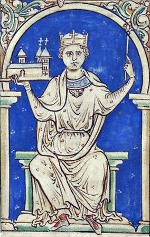
Stephen was born at the end of the 11th Century in Blois, a county to the southeast of Normandy, home of William the Conqueror, his grandfather. Adela of Normandy and England was the Conqueror's daughter, and her husband was Stephen II, Count of Blois; the married couple had 11 children, of which Stephen was the fourth. When Stephen was born, the King of England was William II, known as William Rufus. William was succeeded by his son, Henry I in 1100. Two years later, Stephen's father died on Crusade; Adela reared her children and served as regent of Blois. Stephen was not, as the usual practice was, brought up and educated by a close relative; rather, his mother saw to his upbringing and his teaching, arranging a tutor named William the Norman to teach Stephen history and Latin. 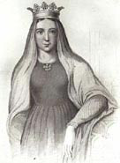
Stephen took up arms with his uncle, King Henry I, in his struggle against his brother; after Henry defeated Robert in Normandy, ending the rebellion, Henry knighted Stephen and gave him some land. A decade later, the king arranged a marriage for Stephen. He married Matilda of Boulogne (right), whose father was Eustace III, Count of Boulogne, and mother was Mary of Scotland, the daughter of King Malcolm III. Stephen and Matilda eventually had three sons and two daughters. Stephen's wife, Matilda, would prove invaluable in his struggle against another woman named Matilda. 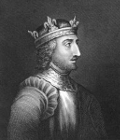
In 1120, five years before Stephen and Matilda married, the only son of King Henry I, William Aetheling, died when the White Ship sank as it left France, bound for England. Nearly 300 other people died on the ship as well. Stephen was meant to be on the ship but did not sail at the last minute because of illness. The death of William Aetheling left Henry I without a son as heir. Six years later, when it appeared that he would have no more children, he named his daughter, Matilda, as heir and required his barons to swear an oath of allegiance to uphold that intention after Henry I died. Henry was on the throne for nine more years, and Stephen stayed at his court for most of that time. Matilda was there as well, even though she was married to a French count. 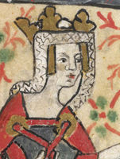
Matilda, as a child, was sent to be the wife of Henry V, the Holy Roman Emperor (who was based in Germany). The couple had no children, and Henry died in 1125. Three years later, Matilda married Geoffrey V, Count of Anjou. They did not like each other and often lived apart. They had a child in 1133 and then, eventually, two more. When Henry I died, on Dec. 11, 1135, Stephen was in Boulogne. He quickly went to England and claimed the throne. His claim was that he was the favored nephew of the recent king and the grandson of William the Conqueror. Stephen also found ready support from several powerful barons who, even though they had pledged to respect the wishes of Henry I with regard to his succession, did not want to see a woman on the throne of England. Henry's daughter, Matilda (known as the Empress Matilda even though her husband the emperor was dead) did not relinquish her claim to the throne. She had powerful supporters in England as well and pressed her claim as the successor to her father, the recently deceased king. A powerful force in support of Matilda's claim invaded England in 1138. Stephen had already been confronted with another invasion, led by King David I of Scotland. The Scottish force seized control of a large part of northern England that was at the time a disputed area; in particular, David claimed ownership of Northumbria. Stephen and an army marched to confront David and his army, and the two leaders came to an arrangement that saw the Scottish force leave in return Stephen's recognition of land claims for David's son. In the meantime, Geoffrey of Anjou, husband of the Empress Matilda, had invaded Normandy and was making plans for an invasion of England, to press his wife's claim to the throne. Another complicated arrangement avoided an armed struggle (at this point). Robert of Gloucester rebelled against Stephen in 1138, choosing to support the claim of his half-sister, the Empress Matilda. Robert found much support for his efforts, at the same time that Stephen was running out of money. As well, King David I of Scotland chose this time to invade again in the North. While Stephen was fighting for his throne and his life in the west, his wife, Matilda, was arranging a treaty with King David I of Scotland, to end the fighting once again in the North. When the fighting in the west stalled, Stephen found himself able to focus on an expected invasion by the Empress Matilda and Robert of Gloucester. (Even though Robert had lands and forces in Gloucester, he had not been involved in the fighting there, preferring to be part of the invasion force coming from France.) The Empress Matilda, Robert of Gloucester, and a large force invaded England in 1139. When Robert and a number of his supporters marched northwest toward Gloucester, leaving Matilda at Arundel Castle, Stephen besieged the castle and considered Matilda captured. He agreed to let her go, the result of a truce whose terms are still not yet known, and Matilda hurried to Gloucester. Forces loyal to Matilda and Robert were in control of much of the southwest of England and part of Wales by 1140. Also at this time, another of Stephen's supporters in the east rebelled. As was the case with other earlier rebels, this one was angered by the king's handing over of lands to the king of Scotland, David I. 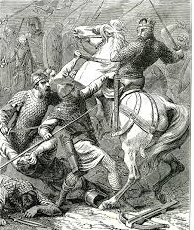
Stephen's difficulties deepened in 1141, when he himself was captured along with a good number of his men at the Battle of Lincoln. He was taken to Gloucester, where he met with the Empress Matilda, who then went to London, intending to see herself crowned Queen of England. At the same time, her husband, Geoffrey of Anjou, seized Normandy. Even though the Empress Matilda had considerable support military and politically, she found herself the target of a popular revolt when she arrived in London. What she had intended to be her coronation turned into a flight to Oxford, with Stephen still the crowned monarch (even though he was being held in chains). Stephen's wife, Queen Matilda, had rallied the troops for several months and found reinforcements enough to give battle in the summer of 1141. The victory for the king's forces was complete when they captured Robert of Gloucester himself. Queen Matilda personally conducted negotiations afterward, trading her husband's freedom for that of Robert of Gloucester. The fighting continued off and on throughout 1142. In September, Stephen's forces had the Empress Matilda trapped at Oxford. Stephen himself led the armed charge, swimming across the Isis River in the process. The empress took refuge in Oxford Castle, and Stephen settled down for a siege, confident of victory at last. Just before the end of the year, the Empress Matilda succeeded in making a daring escape, crossing the icy river on foot without being seen. The struggle continued in 1143, with Robert of Gloucester nearly capturing Stephen again and then a powerful Essex earl rebelling for a time. The many years of fighting without a resolution convinced many on both sides to look for some sort of nonviolent solution. The Empress Matilda went back to Normandy in 1148, a year after her half-brother died. The year before, her oldest son, Henry, had mounted an invasion of England, which was unsuccessful even though the Second Crusade had been too hard to resist for a number of English fighting men. 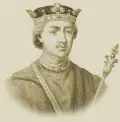
The Empress Matilda did not return to England. Her son, Henry, continued to press her claim. In 1153, Henry (who by this time had married Eleanor of Aquitaine) found Stephen willing to talk terms. Eustace, the eldest son of King Stephen, had died, leaving Stephen without a male heir. Also, Queen Matilda, Stephen's loving wife, had died. With both sides tired of fighting, Stephen and Henry came to an arrangement known as the Treaty of Winchester (which is sometimes called the Treaty of Wallingford). Henry agreed that Stephen was King of England as long as he lived, and Stephen agreed to name Henry his heir. When Stephen died in 1154, Henry became King Henry II of England. Stephen has become known as the monarch who served The Anarchy, as his struggle against the Empress Matilda, has come to be known. Stephen attempted to maintain the legacy of his uncle, Henry I, but managed to alienate many powerful barons and church officials. He found invaluable support in the efforts of his wife, Queen Matilda, and his brother, Henry of Blois, both of whom played vital roles in keeping Stephen on the throne. |
|
Social Studies for Kids
copyright 2002–2026
David White




